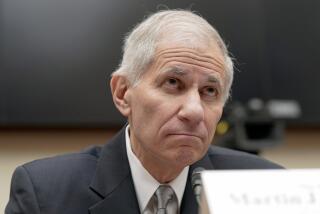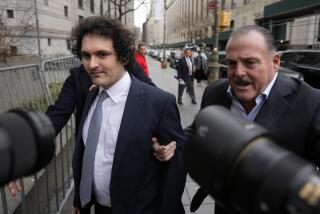$70-Billion Bombshell Needlessly Dropped : Effort to reassure Congress on banks backfired
- Share via
The chairman of the Federal Deposit Insurance Corp., L. William Seidman, dropped a bombshell on Capitol Hill the other day. His testimony that the Bush Administration is seeking $70 billion--not $25 billion--in borrowing authority for the bank insurance program set off new fears about a taxpayer bailout of banks akin to the savings and loan crisis.
Seidman had hoped to assure Congress that the nation’s dwindling insurance fund would have adequate future financing. Instead, he wreaked confusion and new doubts. By misrepresenting the Administration’s proposal, Seidman needlessly complicated an already complicated issue: reform of the nation’s banking system.
It marked an inauspicious start for the Administration’s ambitious effort to sell Congress on freeing banks from Depression-era laws. A crucial element to restructuring banks is replenishing the FDIC fund that protects depositors in the event of a bank failure. The fund is down to $8.5 billion and is expected to decline to $3 billion by the end of this year. Securing additional financing for the fund is a top priority for Congress.
By most accounts, including Seidman’s, the FDIC should be able to adequately get by with an initial infusion of $10 billion. In the bank reform proposal it sent to Congress last week, the Administration, as expected, sought legislative authority for the FDIC to borrow $25 billion from the Federal Reserve System to replenish the dwindling bank insurance fund. The FDIC would repay such a loan from premiums that banks pay to the insurance program.
The Administration also proposed another highly technical modification that would add $45 billion to the FDIC’s line of credit from the Federal Financing Bank. This money would be used only to assume and sell assets of defunct banks. It would be repaid with proceeds from assets sales.
The Administration based the projections for a $45-billion line of credit on a worst-case scenario that included a severe and prolonged recession, according to Robert E. Litan, an economist at the Brookings Institution in Washington. With economic indicators pointing toward a short recession, and a recovery on the way, such borrowing is not likely to be necessary. Indeed, most banks are quite healthy.
“By talking of the full $70 billion, Seidman thought . . . it would be reassuring to the public that the money would be there,” Litan said. “He miscalculated and this is going to send people the wrong signal.”
The red flags already have gone up. “The people are beginning to smell a new taxpayer bailout,” charged Rep. Henry B. Gonzalez (D-Tex.), chairman of the House Banking Committee. Charles A. Bowsher, the comptroller general, accused the Administration of not being candid about seeking a bailout.
Seidman, the FDIC and Treasury owe the public an explanation to clear up this mess. “They just flat blew it,” says Litan.
Seidman and the Administration have been at odds in the past on other matters. But they need to work together to keep the confidence of depositors. Drumming up support for reforming the nation’s banking system is difficult enough without such machinations.
FUND IN TROUBLE
A look at how the Federal Deposit Insurance Corporation’s bank fund has declined over the past four years:
1987: $18.3 billion
1988: $14 billion
1989: $13.2 billion
1990: $8.5 billion
Source: FDIC
More to Read
Get the L.A. Times Politics newsletter
Deeply reported insights into legislation, politics and policy from Sacramento, Washington and beyond. In your inbox twice per week.
You may occasionally receive promotional content from the Los Angeles Times.









